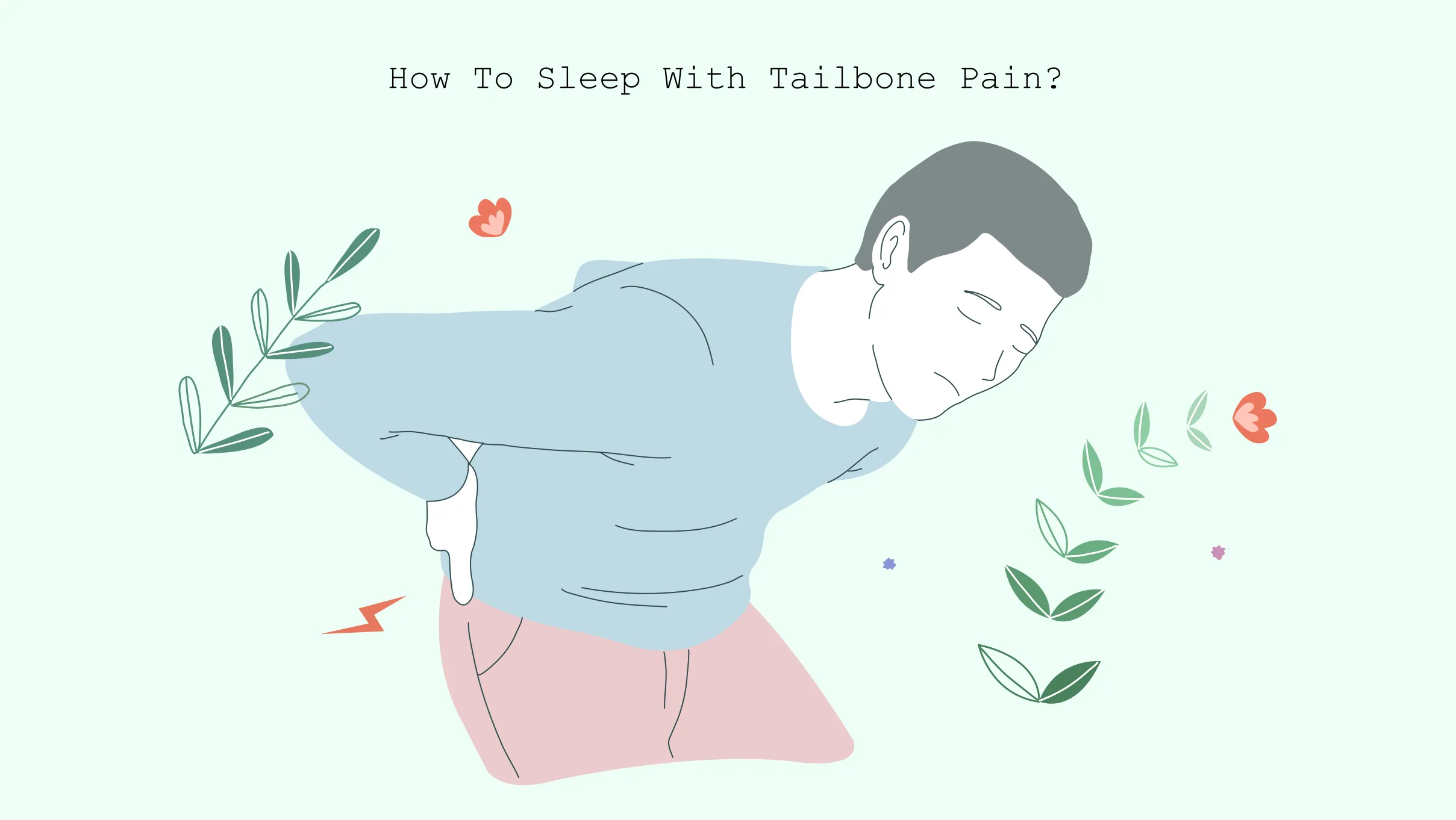How to Sleep With Tailbone Pain
Written by

Medical reviewed by


Also known as coccydynia, tailbone pain is when you go through almost unbearable pain in your coccyx, a small triangular bone located at the bottom of your spinal column. This occurs when the coccyx becomes bruised or fractured. Even the act of sitting down or sleeping can lead to extreme pain. But, with the suitable home remedies, you can manage it. Today, we will explain how to sleep with tailbone pain. Read ahead!
What is Tailbone Pain (Coccydynia)?
Your tailbone comprises of three or four vertebrae, which are present right below the spinal column and are connected to a variety of tendons and ligaments. The pressure directly falls on the coccyx and ischial tuberosities when you sit down. Now, the coccyx must be straight. However, most adults have slightly curved ones. But when the curve becomes abnormal, it can lead to tailbone pain.
The symptoms of tailbone pain include;
- Extreme piercing or sharp pain in your tailbone
- Experiencing severe pain when you transition from sitting to standing
- Severe pain when you have to sit for long periods
- Experiencing pain during bowel movements
- Having pain during sex
Other symptoms associated with this condition include depression, anxiety, poor sleep, pain in your buttocks, and back pain.
If these symptoms seem to be heightened, you must speak with your doctor for proper treatment. In rare cases, tailbone pain can also be a sign of cancer.
What Causes Coccyx/Tailbone Pain?
Let’s look at all the causes of tailbone pain in sleeping.
1. Slip And Fall Accidents
There are instances when you fall on your back by slipping. It can be when you are walking, maybe while working on the ladder, or even a fall when you are simply sitting on your chair. So, falling very hard on your back can bruise your back or dislocate your coccyx.
2. Repetitive Strain Injury Or RSI
Sometimes, there can be a repetitive injury on your back when you cycle or maybe by rowing a boat. Here, the movements are the same and occur in the same spot. This puts a strain on your tailbone and leads to pain.
3. Weight Gain
If you have gained too much weight or are obese, there is additional pressure on the tailbone. When this pressure becomes continuous, it can make the tailbone lean backward. And when the tailbone is pushed further to the extreme, it leads to severe pain.
4. Pregnancy
When you reach the third trimester of your pregnancy, your body secretes hormones that can soften the bones slightly, affecting the tailbone area. It is a natural process that’s necessary to move the tailbone slightly to make childbirth easier. But sometimes, the movement tends to stretch the ligaments and tendons to the extreme and put a strain on the tissues.
5. Anorexia
Anorexia is an eating disorder where you become almost underweight as there is a fear instilled in you that prevents you from consuming the right amount of food. Just like obesity, being underweight can also cause tailbone pain. This is because not enough fat in the buttocks stops the tailbone from rubbing against the muscles and tendons. When the rubbing becomes too much, the tissues get inflamed, causing pain.
Best Sleeping Positions For Tailbone Pain
How to sleep with a bruised tailbone? We bring you the best sleeping positions for your condition so you can enjoy a peaceful slumber.
1. Try Sleeping On Your Side With A Pillow Between Your Legs
Sleeping on your side can be the best position for you as it removes any pressure from the back. This is especially true for pregnant women. To make it more comfortable, you can use a pillow for additional support between the knees to keep the hips aligned. This in turn, puts less pressure on the hips, preventing any push on the tailbone.
Ensure to use a thin pillow between the knees and not something too thick. Also, use a firm and thick pillow beneath your head to keep the spine aligned. This is how to relieve tailbone pain while sleeping. Give it a try.
2. Make Sure You’re Using The Right Pillow
Choosing the right pillow can substantially ease your pain. The shape of the pillow is vital for cervical curves and orthopaedic pillows may help enhance sleep quality. Therefore, a trick as simple as using the right pillow can help prevent tailbone pain while sleeping.
3. Give Sleeping On Your Back A Chance
You may shy away from sleeping on your back because that’s where it hurts. But you can try to sleep on your back with a wedge pillow to support the broken tailbone. Now, it may look like you are putting extra pressure on the back, but that’s not the case here. It can minimise the symptoms and relax the tailbone. If you are a back sleeper, this can help you prevent tailbone pain when lying down.
4. Avoid Sleeping On Your Stomach
One of the worst things you can do with tailbone pain is to sleep on your stomach. While it may seem like a good idea to relieve some pressure, sleeping on your stomach flattens the spine curve. And you also end up twisting your head to the side to breathe. Sleeping on the stomach is in fact not the best sleep position for anyone. If you are wondering why does my tailbone hurt when I lay down, it can also be because you are lying down on your stomach.
Why Does Tailbone Pain Get Worse At Night?
One of the worst things you can do with tailbone pain is to sleep on your stomach. While it may seem like a good idea to relieve some pressure, sleeping on your stomach flattens the spine curve. And you also end up twisting your head to the side to breathe. Sleeping on the stomach is in fact not the best sleep position for anyone. Does your tailbone hurt when you lay down? If yes, the reason can also be if you are lying down on your stomach.
Worst Sleeping Positions For Tailbone Pain
As aforementioned, the worst position for tailbone pain is sleeping on your stomach. In fact, if you are suffering from back pain, it is essential to avoid stomach sleeping. When you opt for this sleeping position for tailbone pain, it puts a lot of pressure on and near the pelvic area. It also extends the spine unnaturally, which can make the inflammation worse. Therefore, sleeping on your stomach must be avoided under all circumstances, as tailbone pain in a sleeping position such as this makes it worse.
How is tailbone pain (coccydynia) treated when a woman is pregnant?
During pregnancy, tailbone pain (coccydynia) can be treated with conservative measures. These include avoiding prolonged sitting or standing, using a cushion or pillow for support while sitting, applying ice or heat packs to the affected area, practicing good posture, gentle stretching exercises, and taking over-the-counter pain relievers (with a doctor’s approval). If these measures are insufficient, a healthcare professional may recommend physical therapy or prescribe pain medications suitable for use during pregnancy.
Conclusion
If you are experiencing mild or temporary tailbone pain, it can get better when treated cautiously. However, if the pain doesn’t seem to be getting better, you must speak with your doctor. You can also use a heat pack or cushion while sitting for relief.
FAQs
Can the Sleeping Position cause Tailbone Pain?
Sleeping position may never be the cause of your tailbone pain. However, sleeping on your stomach or indulging in unhealthy lifestyle choices can aggravate your condition. Therefore, if you suffer from tailbone pain, try to sleep on your side or back with a wedged pillow for some relief.
How Do I Know If My Tailbone Pain Is Serious?
When you choose the right sleeping position and follow other precautions, you must feel the tailbone pain subsiding. However, if the pain doesn’t improve, you must consult your doctor immediately. They may also conduct a rectal exam to rule out any other conditions. An MRI may also be ordered to check for fractures. Some of the treatment methods for this condition include;
- Physical therapy
- Medication
- Surgery
What Should You NOT Do If Your Tailbone Hurts?
If your tailbone hurts, you must not do activities that may put too much strain on the tailbone. It can be lifting heavy objects, sitting in one position for too long, or even sleeping on your stomach.
Is Walking Good For Tailbone Injury?
Yes, walking for short periods can help provide relief. However, don’t overdo it at once. Instead, walk for small durations, several times a day.
How should I sleep with tailbone pain?
To sleep with tailbone pain, try sleeping on your back or side.
people like this article
Written by

Medical reviewed by








